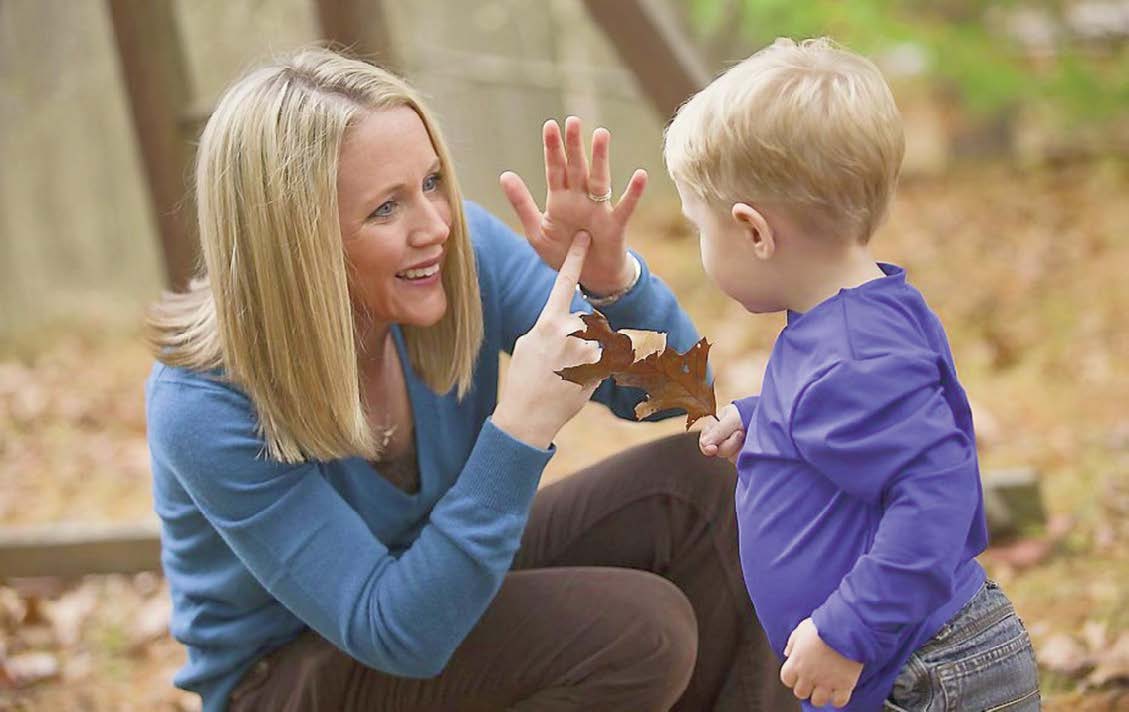
Incidental learning might be defined as what a person learns through informal communicative interactions with others in public and educational settings. For children who can hear, incidental learning constitutes a major portion of their social development and world knowledge. However, for the deaf child, even though surrounded by this type of learning, it is often not accessible. There is extreme naivety on the part of parents and many school administrators and teachers concerning the educational problems linked to communication access that is often denied to children who are deaf. The absence of access to incidental learning may well precipitate the continuing struggle that the deaf child encounters academically.
Accepting the fact that the hearing child receives the bulk of his educational, informational, and learning experience outside of the classroom, this conclusion is not valid for the deaf child who does not hear or only receives partial information through impartial hearing, unless a number of vital conditions are met, understood, and planned for. It is evident that incidental learning is far more important than is realized by many people, including the architects of federal laws that call for an appropriate education in the least restrictive environment. In fact, the lack of any degree of focus on the out-of-the-classroom environment may be the missing link in deaf education. To fully comprehend the crucial need for access to incidental learning, one must investigate the learning environment of the hearing child apart from the time spent in formal schooling. The child who can hear reaches a fairly sophisticated understanding of English syntax, use of idioms, and a full blown vocabulary before they ever set enter a school or formal classroom. During these early pre-kindergarten years the hearing child begins to understand counting, elements of set theory, and other mathematical concepts. They learn a great deal of history and geography from television, radio, and peer and adult conversations. They internalize facts and understandings about social codes and attitudes, health habits, and rules of games. Hearing children, provided there is adequate communication, tend to learn more by example than by precept, more from the world as it is than through admonition, lecturing, or demonstration. In short, they have access to this information because they can hear. The hearing child's total education is readily accessible 24/7. Innumerable teachers, such as the mass media, the home, the street, novels and other literature, self-instructional materials, and what he/she learns from their peer group influence it. Hearing children are able to use their language foundation that is fortified with incidental learning opportunities to expand their education and to extend their learning horizons both in and out of school. They are able to expand their worldview and knowledge. It is, after all, the community that performs the major role of education, not the schools.
For the deaf or hard of hearing child, one will logically ask, "Where is the community?" Where and how is this vital incidental language and access provided? Sadly, the community is often a physical presence, but a mental blankness. Deafness is invisible, so people rarely see beyond the surface. This is where parents, administrators, and teachers often demonstrate their naivety.
It is instructive for the parent, school administrator, and teachers to question the accessibility of the deaf child to incidental learning that occurs every day within the public school classroom. Does the deaf child have access to the language of incidental learning that occurs at the library or media center, during recess, at lunchtime, during formal classes, independent artwork and laboratory classes, after-school activities such as intramurals and varsity athletics, student body government functions and meetings, in extracurricular clubs such as debate, foreign languages, drama, chess, etc.? Far too often, the child is a wallflower, a member of the crowd, present and yet absent, a child with latent leadership abilities undeveloped and left dormant.
The opportunities for the hearing child to acquire knowledge and expand their world thorough access to incidental learning are rampant. For the deaf child in public school settings, this is often not the case. Even though federal laws have been enacted to provide a least restrictive environment and an appropriate education, the implementation of these laws have often not addressed incidental learning. Deaf children are often unable to access incidental learning when they cannot do the following:
• Hear the teacher
• Hear their classmates in front of, behind, and all around them
• Hear and participate in class discussions
• Hear the educational film presented in class
• Hear the principal over the public address system
• Hear the visiting speaker invited to class
• Hear the guide on a field trip
• Hear the peer interactions happening between classes
• Hear the friendly exchanges during recess
• Hear the news and gossip that happens at lunchtime
• Hear the countless happenings that occur as if by osmosis that
C ertainly, a partial solution to the deaf child's dilemma of acquiring incidental learning is a family that has opted to use visual communication so that the child will have better access to language and will be able to better make sense of their community/environment. Another solution is to provide the deaf child with an educational environment that offers a variety of peer contacts and adults who know and use appropriate communication modes, including use in and out of class of captioned films, video phones, and other visual technological advancements. While these positives will not cover the full range of missing elements in the access of incidental learning, they will go a long way in assisting the deaf child during his/her early, crucial years to build the foundations upon which he/she can further their education and use it as a springboard to move confidently into the greater world beyond childhood. Perhaps the most important solution is for the parents, administrators, and teachers is to understand the simple fact that the deaf child does not hear, and the problems outlined above can be remediated by assuring that the child's educational placement be in a residential school or a day-class program where the child can experience easy and accessible communication that naturally embraces access to incidental learning.
If parents opt to not choose a residential program or a day-class program for their child's education and instead choose a mainstreamed or self-contained program in a public hearing school, the following suggestions might be considered to assure access to incidental learning;
The research suggests that teachers and administrators in educational settings should understand the significance of incidental learning. Teachers should find ways to integrate incidental learning with structured learning, exposing deaf and hard of hearing students to as much of the incidental learning that hearing students are able to access. A good example would be to allocate classroom time for discussions on informal topics, such as where students like to socialize and why, favorite books, or what happened at the dinner table last night. Teachers can share information of their own as well, and then relate it to what they are teaching in their formal classroom settings.
The teachers can also set up a role play situation where hearing students portray a deaf or hard of hearing student in a crowd of hearing students or vice versa with the goal being to help each student understand the other's perspective. Students, teacher, and other school staff should see that making an effort to include deaf or hard of hearing students in informal interactions will make a difference.

FAMILY FIRST: A partial solution to the deaf child's dilemma of acquiring incidental learning is a family that has opted to use visual communication so that the child will have better access to language and will be able to better make sense of their community and environment.
Incidental learning is a crucial part of the development of social skills, cognitive skills, and self esteem. Without it, deaf and hard of hearing students are potentially missing out on something as simple as daily gossip or as imperative as having access to social norms or educational topics that could impact their overall social and academic development. When it comes to incidental learning, the key is access.
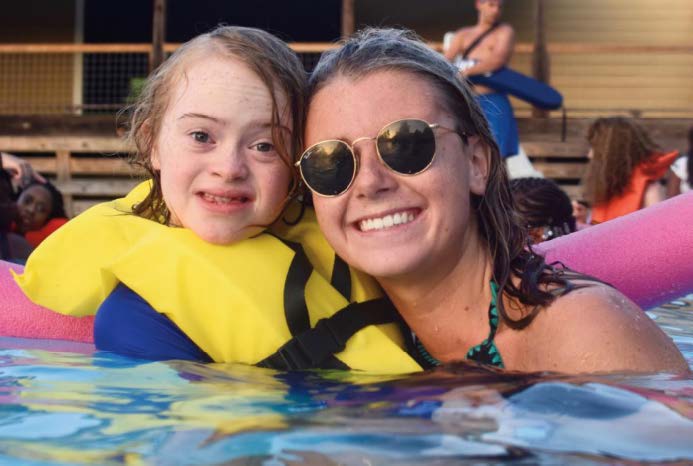
ABOUT THE AUTHOR: J. Freeman King, Ed.D. is Professor, Deaf Education, at Utah State University.
With more than 25 different activities from which to choose, Camp ASCCA is an exciting place to visit. Each activity area offers a unique experience and allows the camper to succeed on his or her own, as well as in an environment of peer support.
Situated in east central Alabama is one of the world's largest year-round barrier-free camps for people with disabilities. Easterseals Camp ASCCA, or "Camp ASCCA" as it's commonly known, is Alabama's Special Camp for Children and Adults. It opened in 1976 and is situated on 230 acres along beautiful Lake Martin, Alabama's largest recreational lake. Camp ASCCA is a place that allows children and adults with disabilities to increase their confidence, improve their physical skills and foster social skills in a fun environment. Over the past 40 years, Camp ASCCA has served nearly 100,000 individuals with disabilities. The mission of Camp ASCCA is to help eligible individuals with disabilities and/or health impairments achieve equality, dignity, and maximum independence. The benefits of the camp experience are immeasurable. The impact that a camp experience can have on increasing confidence and the level of independence often remains long after the camp session has ended. With more than 25 different activities from which to choose, Camp ASCCA is an exciting place to visit. Each activity area offers a unique experience and allows the camper to succeed on his or her own, as well as in an environment of peer support. Camp ASCCA's safe, supportive environment encourages the camper to meet new challenges. The major goal at Camp ASCCA is to serve those who can derive maximum benefit from the resident camp experience and provide a healthier, happier, longer, and more productive life for children and adults of all abilities. Camp ASCCA also accents inclusion by involving non-disabled persons with disabled persons in the resident camping experience. Camp ASCCA promotes the development of socialization, coping skills and independence skills through a series of programs designed to challenge each camper to their maximum potential.
Camp ASCCA means fun for the 5,000+ visitors who spend time at the facility each year. Campers with disabilities such as spinal cord injury, intellectual disability, autism, traumatic brain injury, spina bifida, multiple sclerosis, muscular dystrophy, diabetes, and others enjoy unique camping experiences at Camp ASCCA. Funding for Camp ASCCA comes from a variety of sources, including a state grant, civic groups, foundations, and individual contributors. Through these fundraising efforts, Camp ASCCA has assured, that, to date, no camper has ever been denied participation at camp due to financial hardship. Rather, donations from organizations across Alabama have allowed many campers to experience the thrill of Camp ASCCA. Facilities at Camp ASCCA include the Rotary Dining Social Hall, a spacious lodge with seating for 300, a variety of dorm-style to semi-private sleeping options, such as the Marc Roberts Lodge, Rotary-Lions Lodge, and Davis Lodge, the Rotary-Lions Education Center for meetings and conferences, over one mile of waterfront centered by the Hitchcock Marina, the Oscar C. Dunn-Rotary Environmental Center, which provides hands-on environmental learning, the Hoyt Webb Gymnasium and Pavilion for indoor recreational activities, the Lee Eiland Kravitz lighted baseball and multipurpose field, the Alabama Elks Association Administration Building, the Gunter-Dixon Infirmary, a fully equipped health care center staffed with three nurses during the summer program, Kiwanis Lodge, Rotary Club Therapeutic Swimming Pool, Tennis Pavilion, Kiwanis Fishing Center, ALFA and Farmers Federation Demonstration Farm, Levy-Roswal Adventure Course Area with Accessible Climbing Tower, Accessible Water Playground, a multi-sensory room for campers with autism, The Alabama Pilots and Solon & Martha Dixon miniature golf course, and the Outpost, a multi-purpose outdoor music and entertainment area, and seven permanent residences for our senior staff members. These diverse facilities allow Camp ASCCA to provide a myriad of exciting programming options. All facilities are accessible to people of all abilities. All buildings, except the Conference Center are on one level, with entrance ways by ramp at ground level access. The two story Conference Center has an elevator. Elevated ramp ways, boardwalks and concrete paths throughout the 230 acres allow campers of all abilities and ambulation to explore the outdoor environment.
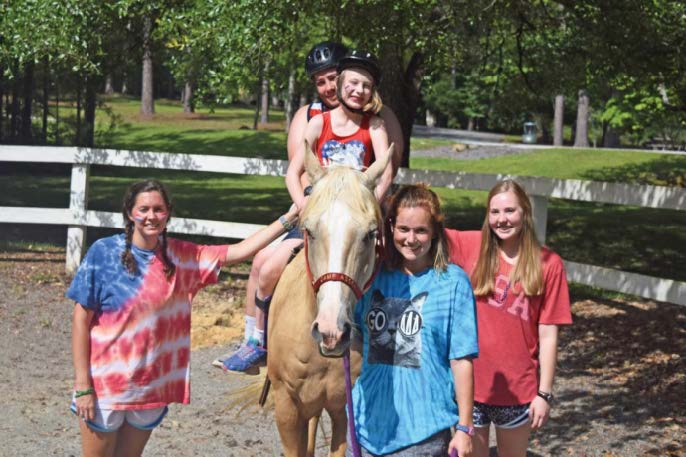
Programs include summer resident and off-season resident camping experiences. The summer program operates from late May to mid-August. The off-season program consists of respite, family, and specialty camps that allow Camp ASCCA to serve a greater number and wider variety of disabled consumers.
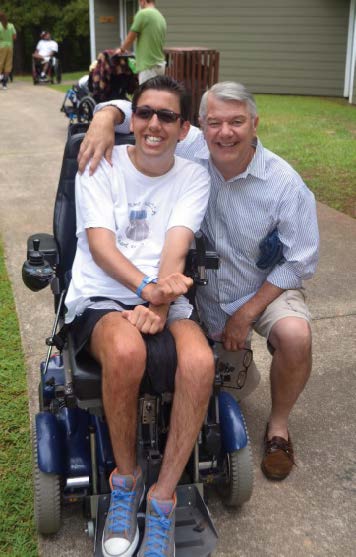
In the aquatics area, campers have an opportunity to experience activities such as water skiing, tubing, pontoon boating, swimming, scuba diving instruction, stand up paddle boards, jet ski rides, and flatwater canoeing and the water playground. Swimming includes recreational swimming and swimming instruction with an emphasis on safety in water. From high adventure tubing and a 250 ft. waterslide, to programs for campers who have never been exposed to water play, the aquatics program offers something for everyone. The largest program area at Camp ASCCA is the Outdoor Education component. This includes wildlife and farm animal studies, horseback riding, fishing, archery, riflery, arts and crafts, along with a variety of sports. Sports activities include a variety of indoor and outdoor sports and both team sports and individual sports.
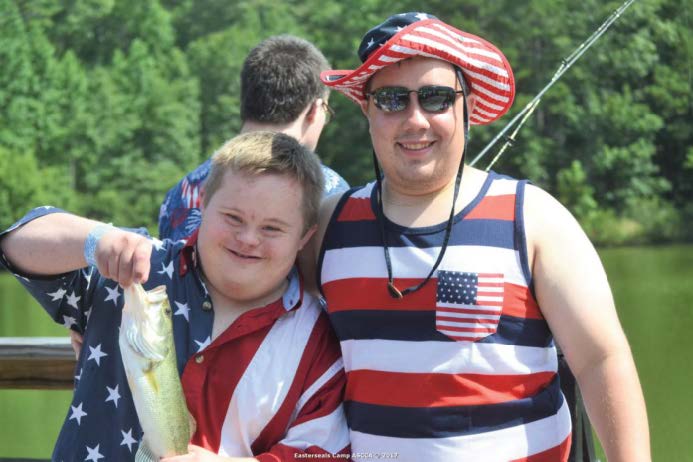
Skill instruction is offered in each sport, as well as recreational and team play. Sports include bocce, floor hockey, adapted golf, golf driving range, puttputt golf, disc golf, tennis, and billiards. For lower skilled campers, ball games and activities are used as lead-in activities. From tennis to basketball, a range of sports that require little or no adaptive equipment are demonstrated at Camp ASCCA.
With barrier-free adventure activities, Camp ASCCA offers children and adults with disabilities a chance to climb a tree, slide down a zip line, climb a 20-foot cargo net, tackle a low ropes course and rappel down a tower. The Camp ASCCA 40-foot high Climbing Tower allows each camper to choose how independent they will be or how much assistance they will receive. The adventure staff has a belay rope rigged to series of rope and carabiner pulleys that allow him/her to provide as much active assistance as is necessary for the camper to ascend the tower successfully. Campers can ascend the tower via a 90-degree climbing side, a 45-degree climbing ramp, or a 60-degree climbing ramp. Access to the tower by wheelchair users is through an accessible ramp and a traverse line. The ramp on the climbing tower allows the participant to wheel their chair to the base of the tower, lock into a harness system and then ascend at their own pace, with or without active assistance from adventure staff.
Once at the top of the tower, the camper is secured to a tether line. After securing the safety of the camper, he/she takes a 300 foot zipline ride. The zipline adventure starts with a leap of faith from the tower platform and a small drop before the zipline catches the fall. As the camper ascends the tower, a counselor moves the wheelchair to the take-off platform, where an innovative take-off platform allows the camper to remain independent throughout the experience. As the camper begins the slide, the take-off platform is in an open position, allowing the camper to slide the length of the zip cable and then pendulum back toward the tower until they come to rest over the take-off platform. The two ends of the platform are pushed together, the zipliner unhooks the seat harness and either walks down the ramp or lowers himself/herself into their chair and wheels down the ramp to the next activity. Truly, inclusion with dignity and maximum independence. This is exhilarating for campers, particularly those that spend a majority of their time in a wheelchair. It is also joyous for parents who have been told many times of the things their child will be unable to do. As stated by John Stephenson, Camp Administrator, "Our goal as an organization is to give each camper the best possible experience every time they visit Camp ASCCA."
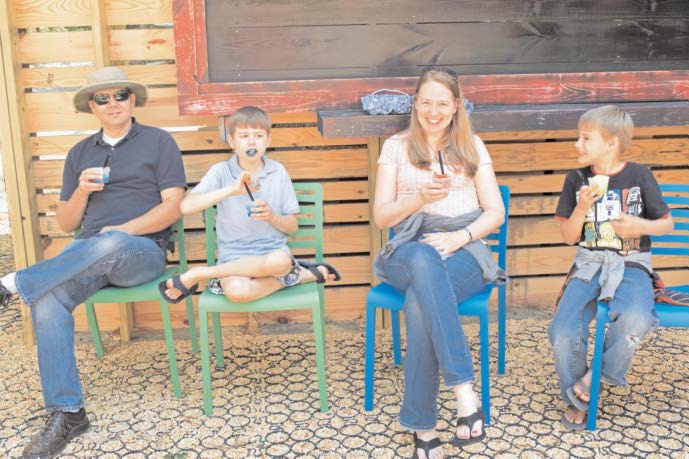
For more information about Camp ASCCA, go to the camp website at campascca.org or contact Dana Rickman, Director of Marketing Communications at dana@campascca.org.
ALL-INCLUSIVE: (Opposite page) A young man and his dad pose for a photo before his week begins at Camp ASCCA. (Above left) Fishing director Justin poses with a proud camper who made the "catch of the day" at the fishing pond. (Above right) A family enjoys shaved ice at the OutPost during the Autism Society of Alabama's Family Weekend. Campers with disabilities such as spinal cord injury, intellectual disability, autism, traumatic brain injury, spina bifida, multiple sclerosis, muscular dystrophy, diabetes, and others enjoy unique camping experiences at Camp ASCCA.